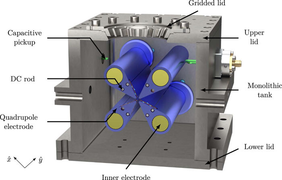Trapped ions are excellent systems for optical frequency metrology, as they can be well isolated from the external environment. Using laser-cooling, ion temperatures below the millikelvin level can be reached, thereby greatly suppressing the relativistic time dilation associated with the thermal motion of the ion. But during interrogation of the clock transition, the cooling laser must be extinguished in order to avoid inducing a systematic shift on the transition frequency. Any noise on the electrodes that produce the electric field to confine the ion then becomes important, as it leads to a slow heating (referred to as anomalous heating) of the ion during the periods when the cooling laser cannot be applied, thereby leading to increased time dilation. Noise sources can range from unstable voltage supplies down to the fundamental Johnson-Nyquist noise caused by the finite resistances of the connecting wires and the electrodes themselves.
The trapping of highly charged ions presents a unique challenge, as the sensitivity of an ion to electric field noise scales with the square of its charge state. This means that an ion with charge state of 10+ would be two orders of magnitude more sensitive than a singly charged ion to a given level of noise. In our previous paper (ArXiv link), we demonstrated that the heating rate could nevertheless be kept to a level comparable to singly charged ions by paying careful attention to various sources of noise. However, further improvements are still necessary in order for atomic clocks based on highly charged ions to reach their full potential.
To this end, our colleagues at the Max-Planck-Institute for Nuclear Physics (MPIK) in Heidelberg have developed a new trap design that promises to further suppress any remaining noise whilst greatly reducing the amount of power required to drive the trap. By directly integrating the ion trap into a superconducting resonator, the quality factor of the resonance can be increased by around 3 orders of magnitude compared to more traditional systems that use an external resonator. This leads to a much stronger filtering of noise on the radiofrequency fields used to confine the ion. The reduced power requirement also allows an increase in the size of the trap, which further reduces the anomalous heating as the electric field noise scales inversely with up to the fourth power of the distance between the ion and the nearest electrode. The reduced power dissipation will also allow lower temperatures to be reached in the cryogenic environment, further reducing Johnson-Nyquist noise.
An accompanying Scilight article, including an interview with the lead author, Dr Julian Stark, can be found here. The paper itself can be found here.
Our article “An ultralow-noise superconducting radio-frequency ion trap for frequency metrology with highly charged ions” has been published in Review of Scientific Instruments.

